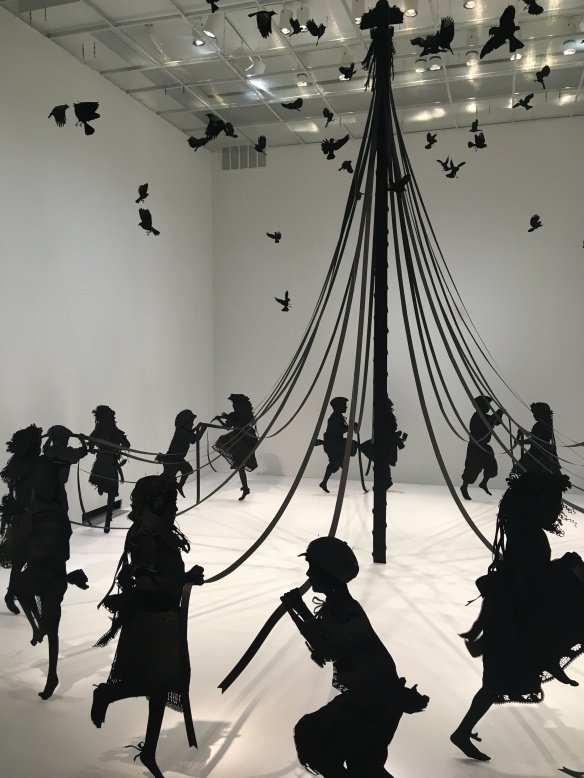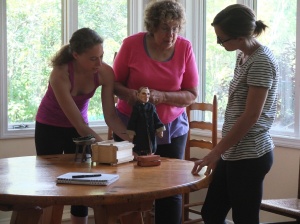by Nina Budabin McQuown
Fairies aren’t human. That’s been one of the key concepts we’ve kept in mind as Wit’s End Puppets has developed our current show, Malevolent Creatures. For us that’s meant spending some time thinking about what it means to represent non-humans. We’ve made some technical choices—representing adult humans with actors and fairies with puppets, for example. For me as a writer, trying to write non-humans with agency is one of the most interesting and important challenges that we might face as makers of art. We understand humanity as subjectivity, the capacity to say “I am,” and that’s why stories about the consciousness of trees and the memories of prairie dogs so often make people uncomfortable. If another being is understood to have consciousness, to know time, to feel pain, we have certain responsibilities toward it: maybe we shouldn’t be cutting down trees or shooting prairie dogs or boiling lobsters alive. What’s even more disturbing, of course, is that nothing really needs to change just because we understand trees to be conscious. Cognitive dissonance is always there to help us out. Humans are notoriously good at revoking the privileges of subjectivity from even their neighbors of the same species when it suits them to do so.
In European fairy-tales since the nineteenth-century, the question of humanity has been ditched entirely in favor of a display of morality, but that’s partly because these stories aren’t really about fairies at all. They’re about people, so they have good fairies and bad fairies. There’s Sleeping Beauty’s wicked fairy queen, and Cinderella’s good fairy godmother. These characters are “good” or “bad” according to human moral systems—do they encourage vanity or sex in young women, or do they reward the values of hard work and humility?
We tend to tell stories about the environment, too, as if they were stories about people: Owls versus loggers, pipelines and banks against native communities, cattle ranchers versus national parks. Human stories have good guys and bad guys, moral stakes and happy or unhappy endings that are based on human social structures and norms and timescales. Growing up on Captain Planet in the nineties (it played on Sunday mornings, when little Jewish kids like me got to watch cartoons), I was raised with that view of environmentalism. There were the bad guys who like to loot and plunder, and the “you” that the show referred to constantly, an us who held the power to save the world by stopping pollution. The world we were supposed to save was “ours,” just like the power to save it—and the environment that Captain Planet described was ours too, a common resource for human beings whose lives and health were negatively affected by pollution. To put it another way, Captain Planet told a story of environmental advocacy based in human rights. Because humans need the land (for water, for shelter, for energy resources, for enjoyment, for food production), it’s their rights we’re defending in conservation efforts. That’s also often the way that we describe conservation in law. Take Juliana v. U.S., a law suit currently being brought by young people to challenge the USA’s inaction on climate change. They’ve based their case on the constitutionally guaranteed right to life, liberty, and property. That means that to make a legal case, they have to bring the radically planet-altering changes of global warming—the sixth extinction, rising sea levels, dead oceans—down to an impediment in the way of a group of individuals’ happy human lives.
As we at Wit’s End now try to tell a story about environmental destruction for the sake of resource extraction, we find ourselves dealing with a story that challenges all of those features—that centers the inhuman in an even more prominent way than the stories of Black Annis or Selkie do. The third part of Malevolent Creatures focuses on Tiddy Mun, a figure from the folklore of the Lancashire and Cambridgeshire fens who represents the whole murky, flooded, malarial, fecund aviary of the fen ecosystem as it was before largescale drainage projects destroyed it starting in the seventeenth-century.

Burwell Fen in Cambridgeshire during a flood.
Yet though he’s certainly a defender of the earth, Tiddy Mun is hardly a champion of human rights. Instead of saving “our” world, he’s out to protect his own, and that means he’s ambivalent towards the humans who inhabit that world and are part of it. It’s Tiddy Mun who brings the floods that destroy houses and crops and lead to outbreaks of malaria, it’s also Tiddy Mun who listens when the people beg for those floods to end and Tiddy Mun who abates them. In the story that’s most often told about Tiddy Mun, he fights back against the destruction of the ecosystem he embodies by destroying the drainage equipment of the engineers who’ve come to drain the fens, killing the engineers themselves, and flooding everything until the common people appease his wrath.

One visual interpretation of Tiddy Mun, by Susan Sorrell Hill.
The story of that drainage, which is a real historical event in seventeenth-century England, is a complex one. In it, the clarity of right and wrong—at least from the point of view of human beings—can be as murky as bog water. On the one hand, the drainage was a clear case of the wealthy and powerful destroying an ecosystem for their own financial gain. King Charles I wanted the fens drained to produce valuable farmland so that he could circumvent the financial control of a hostile Parliament, and local landowners just wanted to cash in. On the other hand, common people in the fens were not necessarily as mad about the fens’ destruction as they were about being cut out of their share of the profits and displaced by foreigners. Before the land was dried out, malaria was an enormous problem in the fens. The common people who lived there and made their living from fishing and fowling were displaced, but on the other hand, the Dutch engineers who performed the drainage were primarily refugees. As Huguenot protestants living in France and the lowlands, they had been persecuted with massacre and expulsion, and they found a sanctuary and a new life in the fens. The several sides to this story are reflected in its histories. In some of them, the fenmen are the heroes, fighting a losing battle against all the most powerful forces of their society. In others, Dutch refugees heroically persist in their drainage project in spite of the anti-progress and anti-foreign violence of the locals.
So from the human perspective, the story of the fen drainage is as complex at least as a modern day tale of gentrification or disaster capitalism. From Tiddy Mun’s perspective though, it’s something else. As the story is told (in dialect, unfortunately) in an 1891 article for the journal Folklore, Tiddy Mun’s rage is against all humans, at least for a time. As the fens dry out, he begins by kidnapping Dutch engineers, but when more engineers come to replace them, he starts to persecute the locals as well. Fevers spread, harvests and livestock die, and so do babies. The people perform a ritual of appeasement to Tiddy Mun, pouring out bowls of water and asking for his forgiveness. It’s interesting to me that the ritual is meant to show Tiddy Mun that “Car-folk wished un well, an’ that a’d give un tha watter back if tha only could.” They’re aware that the water they pour out is just symbolic. They can’t turn the fens back into swamps. They can’t save that ecosystem or the spirits that inhabit it: “that poor au’d Boggarts an’ Jack o’ Lanterns wor clean delved away.” It’s almost a mourning ritual, both for the dead children lost to fever, and for Tiddy Mun himself. The story teller in this article agrees that Tiddy Mun is gone by the time of her telling: “Tiddy Mun’s bin frighted away wi’ tha new ways an’ gear.”
That nothing is “saved” in Tiddy Mun’s story is part of what makes it so interesting to the company as we work on the third part of Malevolent Creatures. In recent studies of the rhetoric of environmentalist and “green” writing, critics have called out the way that nature is often treated as an object of human agency, something outside of human subjects that we act on to save or destroy. This idea of nature as “outside” is, as Timothy Morton has put it, “a fantasy.” We’re just as much a part of “the environment” when we’re sitting in our bedrooms at home or riding in climate-controlled airplane cabins as when we’re perched on top of a mountain, looking out at the clouds below. When it comes to the world we exist in, there is no below. We can’t really save or destroy “our” world, but with radical changes to the ways that we understand what it means to be human, people might be able to start participating in a world that belongs to everything in it. Tiddy Mun’s is an important story in part because it’s a story not of saving the environment, but of human entanglement with the processes of an ecosystem. It’s a story with no good guys and no bad guys, one that can, perhaps, represent the being and agency of inhuman things, the way that we understand some of what the land says to us not because it speaks in our language, but because it’s what we are.















